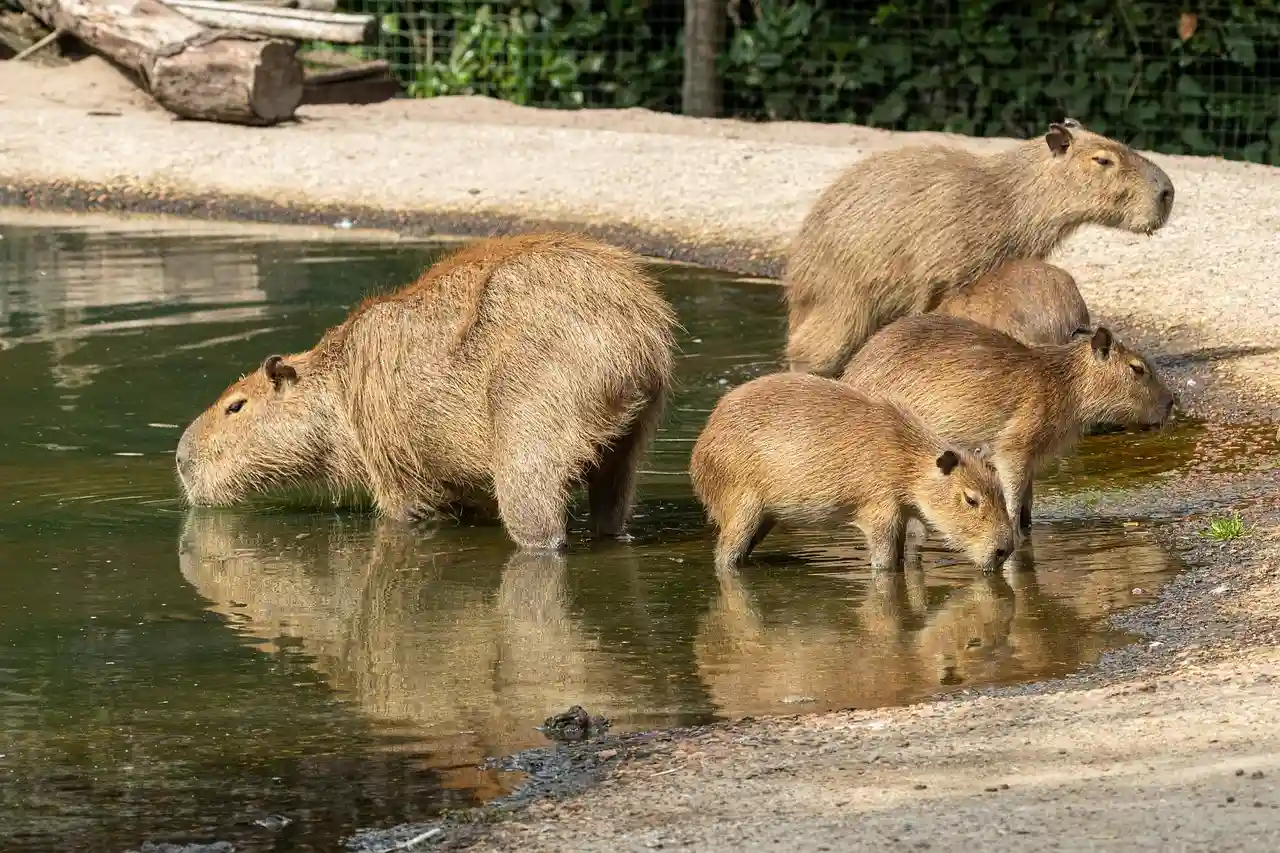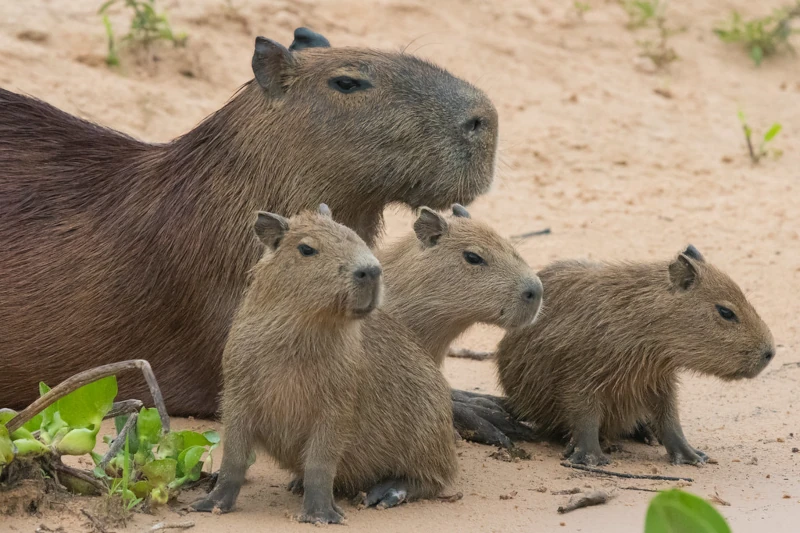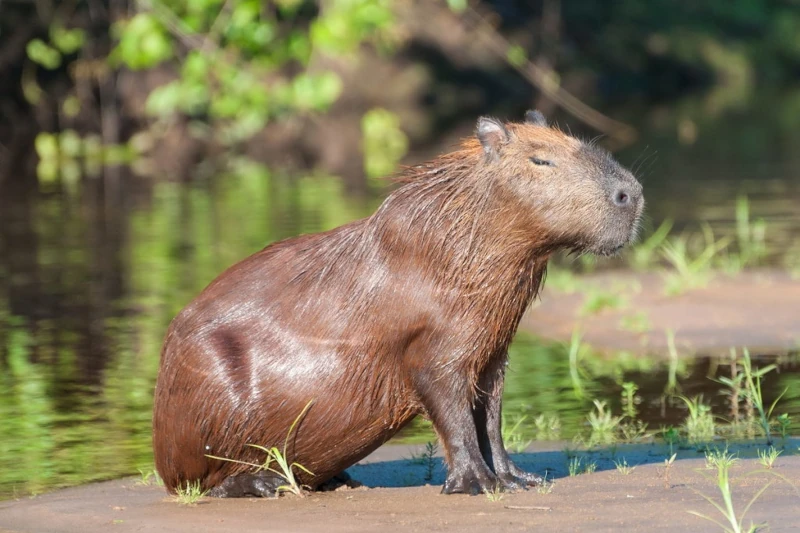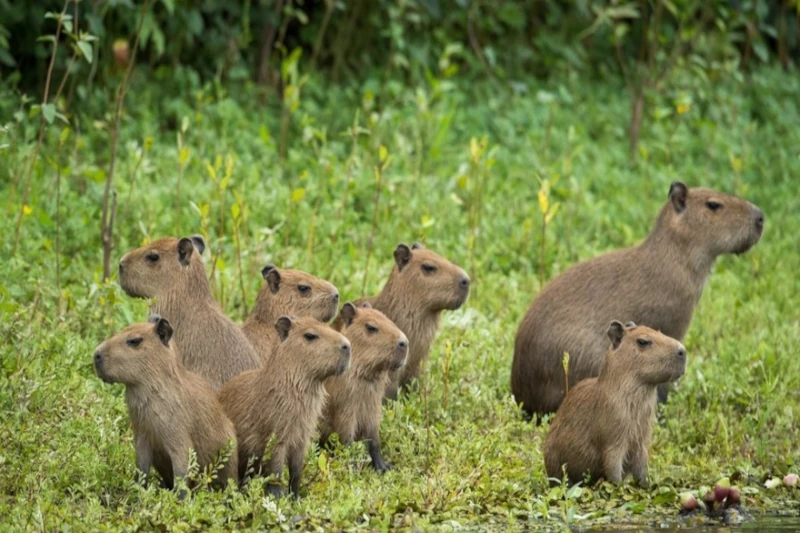Welcome to the Amazon of Peru, a realm of biodiversity. Here, amidst the lush greenery and winding rivers, you’ll find a unique Capybara in Peru. Meet the capybara, the world’s largest rodent. These social animals are a fascinating part of Peru’s wildlife.
In this article, we delve into the world of capybaras. We’ll explore their behavior, habitat, and the role they play in the Amazon ecosystem.
We’ll also share tips for observing these creatures responsibly. Whether you’re a wildlife enthusiast or planning a trip to Peru, this guide is for you. Join us as we journey into the Amazon, uncovering the secrets of the capybaras in Peru.
Understanding Capybaras
Capybaras are native to South America, including the Amazon in Peru. They are semi-aquatic mammals, known for their unique appearance.
Weighing up to 145 pounds, capybaras have a robust body, short head, and webbed feet. These capybara facts features aid them in swimming, a skill they master.
Their diet mainly consists of grasses and aquatic plants. Capybaras can consume up to 3 kilograms of grass per day.
With a lifespan of 8-10 years in the wild, capybaras have a slow reproductive rate. They produce one to eight offspring per litter, contributing to their social structure of Peru wildlife.
You might be interested: All about the Peruvian Amazon tribes

Are capybaras in Peru?
The Capybara in Peru, also known as ronsoco, is a fascinating species that travelers often spot during Puerto Maldonado Amazon tours. They are the largest rodents in the world and can weigh more than 60 kilos. They live mainly in the Amazon, in regions such as Loreto, Ucayali, and Madre de Dios, where rivers, lakes, and wetlands are abundant. In the Pacaya Samiria National Reserve, as well as in Tambopata and Manu, it is common to see them in groups resting by the water or swimming, since they are semi-aquatic animals and excellent swimmers.
Despite their calm nature and ecological importance, capybaras face threats. In some areas they are hunted illegally for their meat and hide, while deforestation and agricultural expansion reduce their natural habitat. For these reasons, conservation initiatives have been developed to protect the species and preserve it as an essential part of Peru’s Amazonian biodiversity.
Capybara Habitat: Thriving in the Amazon
Capybaras thrive in the lush Amazon region of Peru. They prefer habitats close to water bodies, such as rivers, lakes, and swamps.
Their semi-aquatic nature allows them to adapt to these wetland habitats. They often bask in the sun to dry off and regulate their body temperature.
Capybaras are crepuscular, most active during dawn and dusk. This behavior helps them avoid the intense heat of the day.
Their presence in a region indicates the health of aquatic ecosystems. Thus, spotting capybaras in the wild offers a unique Peru animals experience in Peru.
You might be interested: Summer in Peru: 5 top destinations to visit

The Social Life of Capybaras
Capybaras are highly social creatures, living in groups. These groups can range from a few individuals to larger herds of up to 30 members.
They have a complex social structure with a dominant male leading the group. This hierarchical system helps maintain order within the group.
Capybaras communicate through a variety of sounds. These sounds play a crucial role in their social interactions, from warning others of danger to expressing affection.
Capybara Behavior and Diet
Capybaras are crepuscular animals, most active during dawn and dusk. They spend their days lounging in the water or mud to keep cool and avoid insects.
Their diet consists mainly of grasses and aquatic plants. Capybaras can consume up to 3 kilograms of grass per day, using their sharp incisors that constantly grow.
Despite their size, capybaras can run quickly on land. They are also excellent swimmers, with webbed feet aiding in their aquatic lifestyle. They can stay submerged for up to five minutes, a skill they use to evade predators.
Can I feed Capybaras?
Absolutely not. While it might be tempting to offer food to these adorable creatures, feeding wild capybaras is strictly prohibited in all Peruvian protected areas and is strongly discouraged everywhere else.
Health Risks: Human food can cause serious digestive problems, nutritional imbalances, and diseases in capybaras. Their digestive systems are specifically adapted for processing tough grasses and aquatic plants—not bread, chips, or fruits tourists might offer.
Behavioral Changes: Feeding wildlife conditions them to associate humans with food, making them lose their natural wariness. This leads to aggressive behavior when food isn’t provided, creates dangerous human-wildlife conflicts, and can result in animals being removed or euthanized.
Ecosystem Impact: Capybaras that rely on handouts stop grazing naturally, disrupting the ecological balance. They also may abandon important habitats in favor of areas with tourist activity.
The significance of Capybaras in the ecosystem
Capybaras play a crucial role in their ecosystem. They are a keystone species in the Amazon, vital for seed dispersal in their habitats. Their grazing helps maintain the wetland habitats. This activity promotes the growth of certain plant species, contributing to biodiversity. The Capybara in Peru also an essential food source for many Amazon predators. Jaguars, anacondas, and caimans rely on them for sustenance. Their presence indicates the health of aquatic ecosystems. A thriving capybara population often signifies a well-balanced environment.
Threats to Capybaras and conservation Efforts
Despite their adaptability, capybaras in Peru face significant challenges. Hunting for meat and hide persists in remote areas outside protected zones, though less intensively than in neighboring countries. The greater threat is habitat loss—Peru loses approximately 150,000 hectares of Amazon rainforest annually to agriculture, illegal logging, and gold mining. In Madre de Dios, mining operations contaminate waterways, while the Interoceanic Highway has opened previously untouched regions to development. Climate change further complicates survival, with altered rainfall patterns affecting the wetlands capybaras depend on.
The eco-tourism impact
Eco-tourism has become a powerful conservation force. Tambopata alone receives over 50,000 visitors annually, generating $10-15 million USD for local economies. When capybaras generate more income alive through tourism than hunted, communities become their strongest protectors. Indigenous groups and local cooperatives participate in wildlife monitoring and guide training, supported by WWF Peru and the Wildlife Conservation Society.
Your role in conservation
Every responsible visit directly supports capybara protection. Tour fees fund ranger salaries, park maintenance, and research programs. By choosing certified eco-tourism operators, you help ensure these gentle giants thrive for future generations. The capybaras you encounter today depend on the sustainable tourism choices you make.
You might be interested: 40 Animals in the peruvian amazon

Best practices for Capybara watching in Peru
Observing the capybara in Peru offers a unique wildlife experience. However, responsible practices are essential. Our Manu Jungle Tour is perfect to meet these amazing creatures.
Visitors should maintain a safe distance. Feeding wild capybaras is discouraged as it disrupts their natural behavior.
The use of flash photography is not recommended. It can startle these peaceful creatures and cause unnecessary stress.
Eco-lodges and guided tours can enhance the viewing experience. They often provide valuable information about capybaras and their habitat.
Respectful observation guidelines
Maintain distance: Stay at least 10-15 meters (30-50 feet) away from capybaras. Use binoculars or zoom lenses for close-up views. If animals show signs of stress—stopping feeding, entering water, or moving away—you’re too close.
Move quietly: Speak in whispers, walk slowly, and avoid sudden movements. The calmer you are, the more natural behavior you’ll witness.
Follow your guide: Listen to your naturalist guide’s instructions about where to walk and how to behave. They’re trained to read animal behavior and protect both you and the wildlife.
Stay on trails: Never leave designated paths. This protects fragile vegetation and prevents dangerous situations.
What to Bring
- Neutral colors (green, brown, khaki) that blend with the environment
- Long sleeves and pants for sun/insect protection
- Lightweight, quick-dry fabrics
- Wide-brimmed hat
- Waterproof rain jacket
- Closed-toe waterproof hiking boots or shoes
- Extra socks (trails can be muddy)
- Binoculars (8×42 or 10×42 recommended)
- Camera with telephoto lens (200-400mm ideal)
- Extra batteries and memory cards
- Insect repellent (30%+ DEET)
- Sunscreen SPF 50+
- Reusable water bottle (2-3 liters capacity)
- Small backpack or dry bag
- Plastic bags for trash (pack out everything)
Prime locations for Capybara encounters in Peru
Capybaras are found in various parts of Peru. National parks and reserves are prime locations for sightings.
The Pacaya-Samiria National Reserve is a hotspot. It’s known for its rich biodiversity, including capybaras.
Another popular location is the Manu National Park. It offers a diverse range of wildlife, with capybaras being a major attraction.
Here are some top spots for capybara encounters in Peru:
- Pacaya-Samiria National Reserve
- Manu National Park
- Tambopata National Reserve
- Bahuaja-Sonene National Park
- Yanachaga-Chemillen National Park
Remember, always respect the wildlife and their habitats when visiting these locations.
Embracing sustainable tourism
Capybaras, the social creatures of the Amazon, offer a unique wildlife experience in Peru. Their presence in the ecosystem is vital, and observing them responsibly is key.
Sustainable tourism practices not only protect these fascinating creatures but also contribute to the conservation of the Amazon. Let’s embrace these practices and ensure the survival of capybaras for future generations to appreciate.
You might be interested: 15 Traditional food in Peru

Interesting facts about the Capybara Peru
The capybara in Peru is a fascinating animal full of unique characteristics that make it one of the most beloved and surprising species in the Amazon. Below, learn some interesting facts that make it unique.
- It is the largest rodent in the world, reaching over one meter in length and weighing up to 65 kilos.
- It lives mainly in areas of the Peruvian Amazon such as Loreto and Ucayali, near rivers and wetlands.
- It is a great swimmer and can stay underwater for five minutes.
- Its incisors grow throughout its life and wear down thanks to its fibrous diet.
- It lives in social groups that usually number between 10 and 20 capybaras, although during droughts it forms herds of more than 100.
- It communicates through squeals, whistles, and barking sounds.
- It feeds on Amazonian herbs and fruits and coprophagia to better utilize nutrients.
- In some Amazonian communities, it is hunted for its meat and hide, which has prompted conservation efforts.
- It contributes to the ecosystem by controlling the growth of aquatic plants and promoting biodiversity.
- Its calm nature has made it a symbol of calm and tenderness on the internet.
Encounter Capybara in Peru on your next escape
We hope this article has helped you learn everything about the fascinating world of Capybara in Peru and how to plan your perfect encounter with these gentle giants of the Amazon. Now use this information on your next adventure: choose the region that best fits your travel style, book with responsible operators who respect wildlife, and prepare yourself for unforgettable moments observing capybaras in their natural habitat. Remember that every sighting is unique, every encounter is special, and every visit contributes to the conservation of these incredible ecosystems. The Peruvian Amazon awaits you with its crystal-clear waters, overflowing biodiversity, and of course, the stars of the show: the adorable capybaras. Ready for the adventure?



